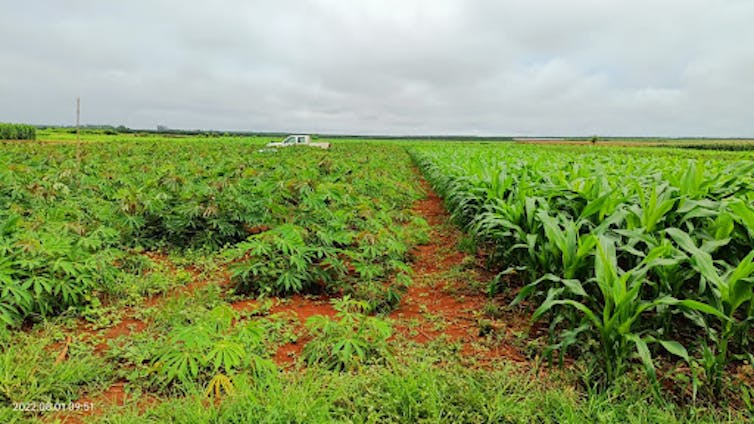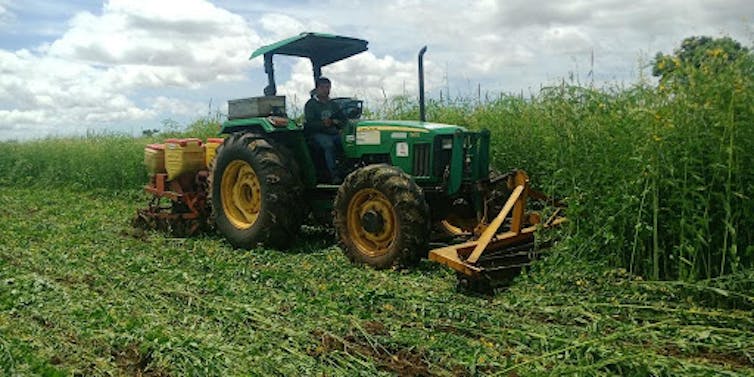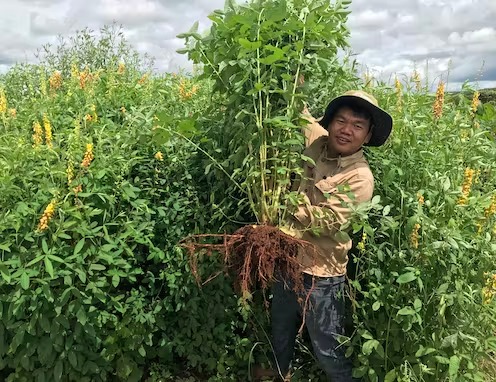It’s right under our feet. We barely notice as we go about our lives, yet it is nothing less than the largest carbon repository among all of Earth’s ecosystems. This distinction is awarded neither to forests, nor to the atmosphere, but to our soils. There are around 2,400 billion tons of carbon in the first two metres below ground, which is three times as much as in the atmosphere.
In our era of climate disruption, there is much to be learned from soil’s impressive capacity for carbon storage. While soils on their own cannot drastically reduce greenhouse gas concentrations in the atmosphere, they can still play a substantial role by keeping sizeable stocks of carbon underground, as well as through the restoration of degraded lands. Today, a number of farming practices are helping trap more carbon below the ground. Here’s how.
How carbon enters soils
It all begins with photosynthesis, when plants absorb atmospheric carbon dioxide (CO2) into their chloroplasts, those small cell organelles that are packed with chlorophyll. CO2 then binds to water molecules (H2O) with the help of solar energy, producing carbohydrates (i.e., carbon-rich molecules) and oxygen (O2). A portion of this carbon captured by the plant enters the soil directly via new and existing roots.
Carbon can also enter soils when a plant sheds its leaves or crop residues are left in fields. This blanket of carbon-rich dead leaves decomposes and eventually ends up as the soil’s organic matter. Animals such as termites can also accelerate the process.
Some regions and ecosystems hold remarkably high carbon stocks in their soils. This is the case for the northernmost regions of the planet, where huge stocks of carbon are preserved in the permafrost, but these are now threatened by global heating. Significant stocks have also been found in tropical ecosystems, particularly rainforests.
The main challenge for carbon-rich ecosystems such as forests, wetlands and permanent pastures is maintaining these stocks. To meet this challenge, we would have to put an end both to deforestation and to converting ecosystems into farmland. An average 25% of the carbon in the soil – and sometimes much more – is lost when forests or wetlands are turned into farmland. Still, certain agricultural practices can sequester additional carbon in the soil. Standardising these practices is one of the objectives of the initiative known as “4 per 1,000”, launched at COP21 in 2015.
Presentation of the 4 per 1,000 initiative.
What are the agricultural practices that increase soil carbon stocks?
There is a whole host of practices to help boost carbon stocks in agricultural soils – from agroforestry to intermediate cover to organic soil enrichment – but three solutions come up more frequently than others:
-
No-till or limited-tillage farming, which involves sowing crops without ploughing or tilling the entire field beforehand. The technique reduces soil erosion, slows down organic matter decomposition due to minimal soil oxygenation and preserves the soil’s biodiversity (worms, in particular).
-
Permanent soil cover: This is either mulch from crop residues left in the field or living plant cover between different crops. This cover protects the soil against erosion, especially water erosion, and traps carbon, all while benefiting soil wildlife (bacteria, fungi, earthworms, etc.).
-
Crop diversification, either through crop rotation or through intercropping. A more diverse crop means less development of bioaggressors and plant diseases, as well as increased productivity for the cultivated plots, owing in particular to the effects of previous crops. For example, a rotation crop of legumes (such as peas, beans, groundnuts, broad beans or lucerne) locks in nitrogen from the air and releases it into the soil, thereby favouring the growth of the next crop. Boosted productivity among crops helps keep more carbon in the plot. As such, a greater amount of carbon then enters the soil, specifically through crop roots.

Crop rotation in Cambodia, with cassava to the left and corn to the right. The crops are alternated yearly on each plot. Vira Leng, Fourni par l'auteur
These practices form what is defined as “conservation agriculture”, and combined, they present real benefits in terms of increasing soil carbon stocks – but only when used together. For example, no-till farming works in some contexts, but not in others. The scientific community was slow to realise this because initial research focused mainly on the first few centimetres of no-till soil, which did in fact show a higher carbon content. But this sometimes coincided with less carbon in the soil’s deeper layers compared to tilled soils, which tend to have a relatively uniform level of carbon at 20 or 30 centimetres deep. As such, there are cases whereby no-till practices can effectively redistribute carbon across the soil profile, but not necessarily bring about the net increase.
Recent research done in sub-Saharan Africa suggests that only by combining the three principles of conservation agriculture can we hope for any significant increase in soil carbon stocks.
Results in Zimbabwe and Cambodia
To understand the benefits from combining these three practices, it is crucial for us to carry out experiments over the long term. It would take an average of five to ten years to detect any significant variation in soil carbon stock.
Fourteen years ago, in Cambodia, the French Agricultural Research Centre for International Development (CIRAD) and the Cambodian Ministry of Agriculture began tests on cassava-based systems. This crop accounts for nearly 700,000 hectares in the country, grown primarily for exportation to produce flour for animal feeds.
By using a combination of no-till and direct sowing, permanent soil cover with plant cover, and crop rotation with corn, we were able to observe a considerable increase in soil carbon. Rates stood at around 0.7 to 0.8 tons per hectare per year at depths of up to 40 cm. The region’s hot, humid climate facilitated permanent soil cover with highly productive plant cover, including legumes (sunn hemp and cowpea) and grasses (millet) between the cassava and corn crops on plots where corn had been sown.
As a result, carbon could be stored all year long due to photosynthesis, while a remarkably deep root system was developed, increasing carbon stocks well below the initial soil layers. This additional carbon storage in the soil will continue until the system reaches a new balance. The plan is to conduct this trial over several decades to ascertain its long-term viability. Once a balance has been reached, the challenge will then be to preserve these carbon stocks by maintaining best practices for soil management.

Corn being grown directly under plant cover in Cambodia. It’s sown directly without the soil being tilled or ploughed. Vira Leng, Fourni par l'auteur
These combined practices were also tested in Zimbabwe, which has a seven-month dry season and five-month rainy season. To do so, we had access to a trial that our fellow researchers at the International Corn and Wheat Improvement Centre set up ten years ago in a low-input farming system whose primary crop was corn. Our experiments were carried out in tilled and no-till fields, with and without corn crop residue (mulch), and with and without rotation using a legume crop of cowpea.
Once again, the results showed little benefit from no-till practices used in isolation, which even revealed a slight loss of soil carbon compared to tillage. This happens because the soil becomes highly compacted when left untilled, restricting root development. In addition, the soil is less able to absorb rain, which ends up as run-off. Because of this, corn develops much less in these systems, resulting in less carbon being transferred into the soil through roots and, therefore, a loss of soil carbon.
On the other hand, the no-till fields that used a mulch from the previous season, as well as crop rotation, saw a rise in their carbon stocks, but this effect was limited to the surface horizon only[E3]. A net increase in the carbon stock was observed, however, as the results indicated no reduction in carbon at lower depths.

Soil core sampling in Zimbabwe as part of a long-term trial for conservation agriculture aimed at quantifying organic carbon stocks. Rémi Cardinael, Fourni par l'auteur
What might hinder the development of these practices?
Despite their promise, these practices are not always easy to implement. For instance, farming in Zimbabwe is based on a low-input, mixed crop-livestock system, which requires little mineral fertilisation and little or no machinery. At harvest time, only the ears of corn are picked by hand, leaving the stalks standing in the field. These stems are then used to feed livestock during the dry season, when cattle, having spent the wet season in forests and communal areas, are brought to fields to graze them.
Consequently, there is a dilemma around whether corn residues should be used to feed livestock or to cover soils. Some farmers erect fences to prevent livestock from eating them during the dry season, but this method has costs. Others harvest the residues, store them away from animals, then gather the mulch during the wet season. All this requires substantial organisation, time and energy, and an alternative source of livestock feed must also be found.
In these regions and elsewhere, the interest for farmers is not only soil carbon sequestration and its benefits for mitigating climate disruption. They also have a positive impact on soil fertility and the resulting crop productivity, which they achieve by reducing the risk of erosion and improving nutrient availability, and they can improve water conservation. Together, these are crucial benefits that are often priorities for farmers in the Global South, who are among those most affected by climate disruption.



 The UK is surprisingly short of water – but more reservoirs aren’t the answer
The UK is surprisingly short of water – but more reservoirs aren’t the answer  Fertile land for growing vegetables is at risk — but a scientific discovery could turn the tide
Fertile land for growing vegetables is at risk — but a scientific discovery could turn the tide  Drug pollution in water is making salmon take more risks – new research
Drug pollution in water is making salmon take more risks – new research  Parasites are ecological dark matter – and they need protecting
Parasites are ecological dark matter – and they need protecting  We combed through old botanical surveys to track how plants on Australia’s islands are changing
We combed through old botanical surveys to track how plants on Australia’s islands are changing  Thousands of satellites are due to burn up in the atmosphere every year – damaging the ozone layer and changing the climate
Thousands of satellites are due to burn up in the atmosphere every year – damaging the ozone layer and changing the climate  How ongoing deforestation is rooted in colonialism and its management practices
How ongoing deforestation is rooted in colonialism and its management practices  LA fires: Long-term exposure to wildfire smoke is poorly understood − and a growing risk
LA fires: Long-term exposure to wildfire smoke is poorly understood − and a growing risk  Fungi are among the planet’s most important organisms — yet they continue to be overlooked in conservation strategies
Fungi are among the planet’s most important organisms — yet they continue to be overlooked in conservation strategies  Extreme heat, flooding, wildfires – Colorado’s formerly incarcerated people on the hazards they faced behind bars
Extreme heat, flooding, wildfires – Colorado’s formerly incarcerated people on the hazards they faced behind bars  How is Antarctica melting, exactly? Crucial details are beginning to come into focus
How is Antarctica melting, exactly? Crucial details are beginning to come into focus  GesiaPlatform Launches Carbon-Neutral Lifestyle App ‘Net Zero Heroes’
GesiaPlatform Launches Carbon-Neutral Lifestyle App ‘Net Zero Heroes’  As the Black Summer megafires neared, people rallied to save wildlife and domestic animals. But it came at a real cost
As the Black Summer megafires neared, people rallied to save wildlife and domestic animals. But it came at a real cost 


































